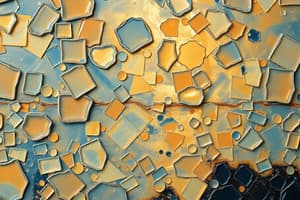Podcast
Questions and Answers
What process is described as influencing the survival of certain glass-ceramics in prosthetic dentistry?
What process is described as influencing the survival of certain glass-ceramics in prosthetic dentistry?
What characteristic is NOT mentioned as a dominant trait for glass-ceramics in dentistry?
What characteristic is NOT mentioned as a dominant trait for glass-ceramics in dentistry?
Which glass-ceramic product line was discontinued in 2015 due to competition from dental zirconias?
Which glass-ceramic product line was discontinued in 2015 due to competition from dental zirconias?
What is a reason that machinable lithium disilicates are gaining popularity?
What is a reason that machinable lithium disilicates are gaining popularity?
Signup and view all the answers
What strategy have companies employed to promote lithium silicates?
What strategy have companies employed to promote lithium silicates?
Signup and view all the answers
Which statement correctly reflects the fate of lithium disilicates in the dental market?
Which statement correctly reflects the fate of lithium disilicates in the dental market?
Signup and view all the answers
How does the evolution of dental materials differ from biological evolution?
How does the evolution of dental materials differ from biological evolution?
Signup and view all the answers
What trait has contributed to the extinction of certain glass-ceramic compositions?
What trait has contributed to the extinction of certain glass-ceramic compositions?
Signup and view all the answers
Which aspect is highlighted as influencing consumer behavior in the dental materials market?
Which aspect is highlighted as influencing consumer behavior in the dental materials market?
Signup and view all the answers
What has led to the consolidation of lithium (di)silicates and dental zirconias in the dental ceramics market?
What has led to the consolidation of lithium (di)silicates and dental zirconias in the dental ceramics market?
Signup and view all the answers
Which type of dental restoration has monolithic translucent zirconias started to claim?
Which type of dental restoration has monolithic translucent zirconias started to claim?
Signup and view all the answers
What challenge do companies face when trying to create lithium-based glass-ceramics without infringing patents?
What challenge do companies face when trying to create lithium-based glass-ceramics without infringing patents?
Signup and view all the answers
What essential material was discovered by Stanley D. Stookey and is a precursor to modern dental glass-ceramics?
What essential material was discovered by Stanley D. Stookey and is a precursor to modern dental glass-ceramics?
Signup and view all the answers
What is the stoichiometric ratio of SiO2 to Li2O in lithium disilicate glass compositions?
What is the stoichiometric ratio of SiO2 to Li2O in lithium disilicate glass compositions?
Signup and view all the answers
Which of the following statements accurately describes the crystallization process of lithium-based glasses?
Which of the following statements accurately describes the crystallization process of lithium-based glasses?
Signup and view all the answers
What role do other oxides play in the composition of dental lithium-based glass-ceramics?
What role do other oxides play in the composition of dental lithium-based glass-ceramics?
Signup and view all the answers
What does the term 'lithium (di)silicate' refer to within the context of dental ceramics?
What does the term 'lithium (di)silicate' refer to within the context of dental ceramics?
Signup and view all the answers
What is a common legal issue companies face regarding lithium disilicate products?
What is a common legal issue companies face regarding lithium disilicate products?
Signup and view all the answers
Study Notes
Glass-Ceramics in Dentistry
- Lithium (di)silicate glass-ceramics are currently the leading materials used for prosthetics in dentistry.
- Their popularity has led to other glass-ceramic compositions becoming less common.
- This shift is driven by a combination of factors, including mechanical and optical properties, ease of fabrication, cost-effectiveness, and marketing strategies.
- For example, Lithium disilicates gained popularity due to their superior mechanical performance and comparable esthetics.
- However, machinable analogs are now gaining market share due to ease of processing, cost-effectiveness, and the chairside aspect.
- Some newer lithium silicate compositions benefit from the reputation of lithium disilicate, gaining market share but with inferior mechanical properties.
- The result is a shrinking diversity of ceramic materials being used in dentistry, with lithium (di)silicates and dental zirconias becoming the major players.
Lithium (Di)silicate Composition
- Lithium (di)silicate glass-ceramics are not stoichiometric, but based on multicomponent glasses.
- They are not limited to just Lithium disilicate and Lithium silicate.
- Other oxides like Al2O3, K2O, CeO2, and trace oxides are added to:
- Decrease melting temperature and viscosity.
- Increase resistance to chemical solubility.
- Accelerate crystallization kinetics.
- Nucleation agents like Phosphorus pentoxide (P2O5) are also used.
- The term 'lithium disilicate' is often used informally for materials with a predominantly Li2Si2O5 phase. Lithium silicate' is used for materials with mainly Li2SiO3 phase.
- For materials containing both Li2SiO3 and Li2Si2O5, the term 'lithium (di)silicate' is still widely used.
- The majority of dental glass-ceramic compositions contain small amounts of both phases, making them neither strictly a lithium disilicate nor a lithium silicate.
Studying That Suits You
Use AI to generate personalized quizzes and flashcards to suit your learning preferences.
Description
Test your knowledge on the role of glass-ceramics, particularly lithium (di)silicates, in modern dentistry. This quiz covers their properties, market trends, and comparisons with other materials. Dive into the mechanics and aesthetics that make these materials popular for dental prosthetics.




